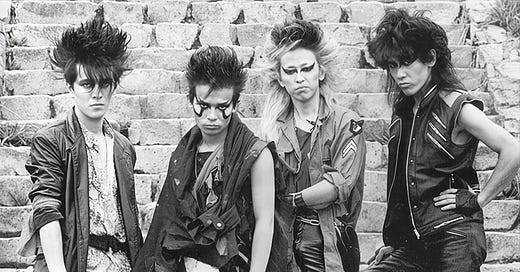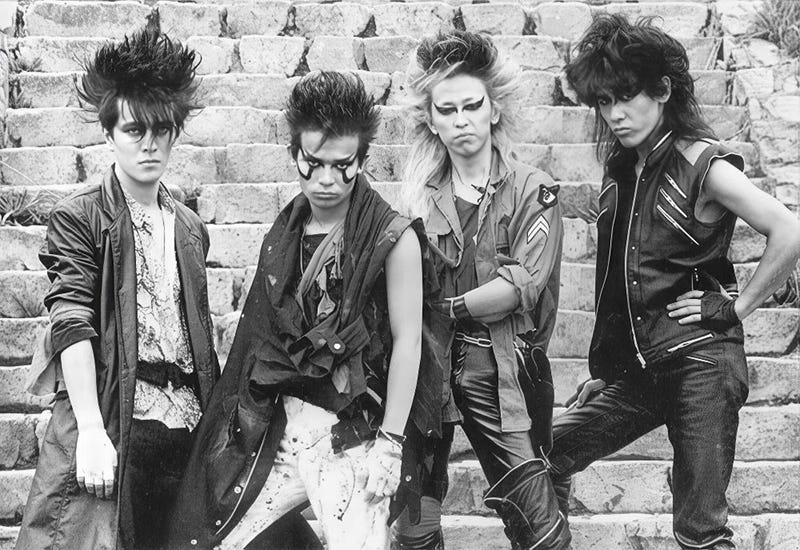EZO | History of the Band
Heavy Riffs, Haunting Hooks, and a Theatrical Edge: Tracing EZO’s Journey Through 80s Metal
EZO, a Japanese heavy metal band, emerged in the 1980s, leaving a distinctive mark on the metal scene with their theatrical style and powerful sound. Their journey from Sapporo’s underground music scene to international recognition is a testament to their dedication and unique artistry.
In the spring of 1982, EZO was formed in Sapporo, Japan, from the remnants of two high school bands, Power-Station and Scrap. The original lineup featured Masaki Yamada on vocals, Shoyo Iida on guitar, Taro Takahashi on bass, and Hirotsugu Homma on drums. Initially, they performed under the name Flatbacker, releasing a demo cassette titled Minagoroshi in 1984, followed by two albums, Accident (1985) and Esa (1986), which showcased a heavier and faster style compared to their later works.
Mr Midnight suggested this artist for a future Dig Me Out podcast episode. Each month, our Patrons are presented with a selection of albums suggested by listeners and asked to vote for their favorite.
Musical Style and Evolution
Flatbacker’s early music was characterized by aggressive speed and heavy metal elements, aligning with the burgeoning thrash metal movement. Upon rebranding as EZO and relocating to the United States, their sound evolved to incorporate glam metal influences, blending melodic hooks with their heavy metal roots. This transition aimed to appeal to a broader international audience while retaining the band’s distinctive edge.
Discography and Notable 80s Albums
EZO’s discography in the 1980s includes two significant albums released under Geffen Records:
• EZO (1987): EZO’s self-titled debut album was a milestone for Japanese metal. Released by Geffen Records and produced by none other than Gene Simmons of KISS, the album marked the first time a Japanese metal band received such a significant push in the American market.
The album featured a star-studded lineup of contributors:
• James Christian (House of Lords) co-wrote the single “Flashback Heart Attack.”
• Jamie St. James (Black N’ Blue) contributed to the writing of both “House of 1,000 Pleasures” and “Mr. Midnight.”
• Kip Winger lent his voice to backing vocals.
Unlike the party anthems dominating the Sunset Strip scene, EZO’s debut was darker, heavier, and more serious. Songs like “House of 1,000 Pleasures” and “Flashback Heart Attack” explored themes of desire, mortality, and inner demons, standing out in stark contrast to the feel-good glam hits of the day.
The album reached No. 150 on the Billboard 200, a respectable entry for a debut from a Japanese band. However, it left fans wondering: Did EZO get noticed because of their connections to Simmons and Geffen, or did the music stand on its own merits?
• Fire Fire (1989): Continuing their collaboration with Western producers, this album showcased a refined sound with tracks such as “Fire Fire” and “Night Crawler.” Despite their efforts, the album did not achieve significant commercial success, leading to challenges in sustaining their presence in the competitive metal scene.
EZO’s American debut received mixed reviews. Critics acknowledged their musicianship and theatrical stage presence but noted the challenges they faced in distinguishing themselves within the saturated glam metal market of the late 1980s. Their unique blend of Japanese cultural elements with Western metal was both a point of intrigue and a barrier to broader acceptance.
Influence and Legacy
Although EZO disbanded in 1990, their impact on the metal genre, particularly in Japan, is noteworthy. Members Masaki Yamada and Hirotsugu Homma later joined the renowned Japanese metal band Loudness in the 1990s, contributing to its evolving sound. EZO’s fusion of Eastern and Western musical styles paved the way for future Japanese bands seeking international recognition. Their theatrical performances and distinctive sound continue to be remembered by metal enthusiasts, highlighting their role in the global metal narrative.
EZO’s journey through the 1980s metal scene reflects the dynamic interplay between cultural identity and musical expression. Their evolution from Flatbacker’s aggressive speed metal to EZO’s glam-infused heavy metal illustrates their adaptability and ambition. While they may not have achieved enduring commercial success, their contributions remain a unique piece of the larger tapestry of 80s and early 90s metal history.






Wow! There's a deep cut; someone tried to make them a thing for like, 1 month in, 1985? ‘86?
Can't even remember…